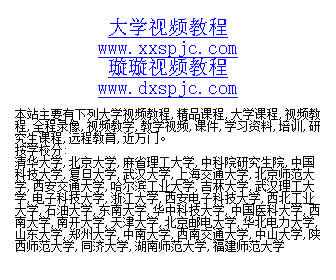![《色彩的科学》(The Science of Color)第二版[PDF]](http://pic.dxspjc.com/dx_pic/9101911/2347798.jpg)
色 彩的科学第二版集中着眼于作为现代色彩科学基础的原理和观测资料。本书为普通科学读者而写,广泛得覆盖了来自物理学,生理学和心理学的关于色彩和绘图的重 要的跨学科领域之课题。本书初版的封皮上把本书描述为“为科学家,艺术家,制造商与学生而写的关于色彩的权威著作”。本版也面向更广泛的读者。
本书从追踪十七世纪开始的关于色彩的科学思考开始。通过追随三百多年间的进步与错误,这历史性的视角提供了对色彩科学基础问题的介绍。
![《色彩的科学》(The Science of Color)第二版[PDF]](http://pic.dxspjc.com/dx_pic/9101911/2347566.jpg)
===============
This second edition of The Science of Color focuses on the principles and observations that are foundations of modern color science. Written for a general scientific audience, the book broadly covers essential topics in the interdisciplinary field of color, drawing from physics, physiology and psychology. The jacket of the original edition of the book described it as "the definitive book on color, for scientists, artists, manufacturers and students." This edition also aims for a broad audience.
The book begins by tracing scientific thinking about color since the seventeenth century. This historical perspective provides an introduction to the fundamental questions in color science, by following advances as well as misconceptions over more than 300 years.
# Hardcover: 350 pages
# Publisher: Elsevier Science; 2 edition (July 25, 2003)
# Language: English
# ISBN-10: 0444512519
# ISBN-13: 978-0444512512
# Product Dimensions: 10.3 x 7.7 x 0.9 inches
![《色彩的科学》(The Science of Color)第二版[PDF]](http://pic.dxspjc.com/dx_pic/9101911/2347827.jpg)
![《色彩的科学》(The Science of Color)第二版[PDF]](http://pic.dxspjc.com/dx_pic/9101911/2347352.jpg)
目录:
Preface
Contributors
1. The Origins of Modern Color Science J.D.Mollon
1.1 Newton
1.2 The trichromacy of color mixture
1.3 Interference colors
1.4 The ultra-violet, the infra-red, and the spectral sensitivity of the eye
1.5 Color constancy, color contrast and color harmony
1.6 Color deficiency
1.7 The golden age (1850–1931)
1.8 Nerves and sensations
Further reading
References
2. Light, the Retinal Image, and Photoreceptors Orin Packer and David R.William
2.1 Introduction
2.2 The light stimulus
2.3 Sources of light loss in the eye
2.4 Sources of blur in the retinal image
2.5 Photoreceptor optics
2.6 Photoreceptor topography and sampling
2.7 Summary
2.8 Appendix A:Quantifying the light stimulus
2.9 Appendix B: Generalized pupil function and image formation
Acknowledgments
References
3. Color Matching and Color Discrimination Vivianne C. Smith and Joel Pokorny
3.1 Introduction
3.2 Color mixture
3.3 Chromatic detection
3.4 Chromatic discrimination
3.5 Congenital color defect
Acknowledgments
Notes
References
4. Color Appearance Steven K. Shevell
4.1 Introduction
4.2 Unrelated colors
4.3 Related colors
4.4 Color constancy
Notes
References
5. Color Appearance and Color Difference Specification David H. Brainard
5.1 Introduction
5.2 Color order systems
5.3 Color difference systems
5.4 Current directions in color specification
Acknowledgments
Notes
References
6. The Physiology of Color Vision Peter Lennie
6.1 Introduction
6.2 Photoreceptors
6.3 Intermediate retinal neurons
6.4 Ganglion cells and LGN cells
6.5 Cortex
Acknowledgments
Notes
References
7. The Physics and Chemistry of Color: the 15 Mechanisms Kurt Nassau
7.1 Overview: 15 causes of color
7.2 Introduction to the physics and chemistry of color
7.3 Mechanism 1: Color from incandescence
7.4 Mechanism 2: Color from gas excitation
7.5 Mechanism 3: Color from vibrations and rotations
7.6 Mechanisms 4 and 5: Color from ligand field effects
7.7 Mechanism 6: Color from molecular orbitals
7.8 Mechanism 7: Color from charge transfer
7.9 Mechanism 8: Metallic colors from band theory
7.10 Mechanism 9: Color in semiconductors
7.11 Mechanism 10: Color from impurities in semiconductors
7.12 Mechanism 11: Color from color centers
7.13 Mechanism 12: Color from dispersion
7.14 Mechanism 13: Color from scattering
7.15 Mechanism 14: Color from interference without diffraction
7.16 Mechanism 15: Color from diffraction
Further reading
References
8. Digital Color Reproduction Brian A.Wandell and Louis D. Silverstein
8.1 Introduction and overview
8.2 Imaging as a communications channel
8.3 Image capture
8.4 Electronic image displays
8.5 Printing
8.6 Key words
8.7 Conclusions
Acknowledgments
References
Author index
Subject index

